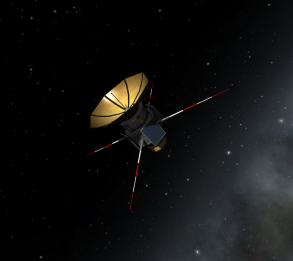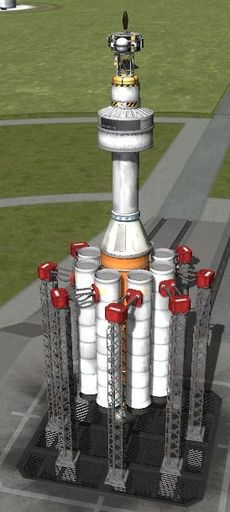Difference between revisions of "Tutorial: Basic Probe And Satellite Building"
Insert name (talk | contribs) (→How To Build A Basic Satellite: added bit about command modules, this needs a lot more work) |
Doctor Acula (talk | contribs) (→How To Build A Basic Satellite) |
||
| Line 11: | Line 11: | ||
{{outdated}} | {{outdated}} | ||
== How To Build A Basic Satellite == | == How To Build A Basic Satellite == | ||
| − | Probe or Satellite stage: First you need an unmanned command module right at the top of the rocket. You can choose from the range of unmanned [[command module]]s. The [[Stayputnik Mk. 1]] looks cool, but it has no [[SAS]]. the [[ | + | Probe or Satellite stage: First you need an unmanned command module right at the top of the rocket. You can choose from the range of unmanned [[command module]]s. The [[Stayputnik Mk. 1]] looks cool, but it has no [[SAS]]. the [[OKTO]] and [[HECS]] have limited SAS capabilities and are cheap, making them good for early career satellites. The [[otko2]] and [[qube]] are very light but have no reaction wheels. The [[rgu]], [[rgu-l]], [[mk2 probe core]], and [[hecs2]] have excellent batteries and reaction wheels with full [[SAS]], but are expensive, making them a good choice for late game career and sandbox missions. Below the Command Pod, you should add some Rechargeable Battery Banks. I used the [[Z-1k Rechargeable Battery Bank]] due to its high Electricity Composite of 500 E; Use about three of them together for 1500 units of Electricity. Use two [[OX-4L 1x6 Photovoltaic Panels]] on both sides of the Battery Banks, use the symmetry option (the 'x' key) in the VAB and set it to 2. |
Now you want to control your probe so add tiny parts for a light weight probe or satellite. Use two [[Stratus-V Roundified Monopropellant Tank]]s on opposite sides to the solar panels and four [[RV-105 RCS Thruster Block]]s, two [[ROUND-8 Toroidal Fuel Tank]]s and a small Liquid Fuel Engine at the bottom of the probe; use the [[LV-909 Liquid Fuel Engine]]. | Now you want to control your probe so add tiny parts for a light weight probe or satellite. Use two [[Stratus-V Roundified Monopropellant Tank]]s on opposite sides to the solar panels and four [[RV-105 RCS Thruster Block]]s, two [[ROUND-8 Toroidal Fuel Tank]]s and a small Liquid Fuel Engine at the bottom of the probe; use the [[LV-909 Liquid Fuel Engine]]. | ||
Revision as of 14:15, 26 November 2016
Probes and Satellites are two different things so this is a tutorial to help you understand what they are, what they do, and how you can build one in Kerbal Space Program.
A probe is a spacecraft that travels through space to collect science information. Probes do not have astronauts. Probes send data back for scientists to study.
A satellite is something that orbits a celestial body. For example, Earth is a satellite because it orbits the sun. Likewise, the moon is a satellite because it orbits Earth. To differentiate between pre-existing and new satellites, the moon is a natural satellite while a human made satellite is called an artificial satellite. The adjective is dropped when it is clear what type of satellite is mentioned. As this tutorial is about satellites launched by Kerbals, the satellites mentioned in this article are all artificial satellites.
Probes and satellites are generally much smaller than manned vehicles, and thus require less energy to lift them out of Kerbin's gravity well. You can build them in either the VAB or the SPH, but this tutorial will focus on the Vehicle Assembly Building (VAB).
| This page or section is in need of being brought up to date. Please help Kerbal Space Program Wiki by fixing inaccurate or outdated information. |
Contents
How To Build A Basic Satellite
Probe or Satellite stage: First you need an unmanned command module right at the top of the rocket. You can choose from the range of unmanned command modules. The Stayputnik Mk. 1 looks cool, but it has no SAS. the OKTO and HECS have limited SAS capabilities and are cheap, making them good for early career satellites. The otko2 and qube are very light but have no reaction wheels. The rgu, rgu-l, mk2 probe core, and hecs2 have excellent batteries and reaction wheels with full SAS, but are expensive, making them a good choice for late game career and sandbox missions. Below the Command Pod, you should add some Rechargeable Battery Banks. I used the Z-1k Rechargeable Battery Bank due to its high Electricity Composite of 500 E; Use about three of them together for 1500 units of Electricity. Use two OX-4L 1x6 Photovoltaic Panels on both sides of the Battery Banks, use the symmetry option (the 'x' key) in the VAB and set it to 2.
Now you want to control your probe so add tiny parts for a light weight probe or satellite. Use two Stratus-V Roundified Monopropellant Tanks on opposite sides to the solar panels and four RV-105 RCS Thruster Blocks, two ROUND-8 Toroidal Fuel Tanks and a small Liquid Fuel Engine at the bottom of the probe; use the LV-909 Liquid Fuel Engine.
You can add some Scientific Antennas to transmit scientific data back to Kerbin. Use one Communotron 88-88 right on the top of your Stayputnik Mk.2 and four Communotron 16. Change the Symmetry Mode to 4 and place them just below the Communotron 88-88 half way down the Command Pod.
Lastly, you will need a separator (like the TR-18D Stack Separator) so put one just below your engine.
Stage One: This stage needs to be as short as possible so it doesn’t wobble about when you launch and needs to be aerodynamic to reduce drag. Attach a Rockomax Brand Adapter below the separator. Use a Rockomax X200-8 Fuel Tank and an Advanced S.A.S Module, Large between the Fuel tank and the Adapter.
Put a Rockomax Brand Adapter 02 at the bottom and make sure the flat end is pointed up (use W,A,S,D,Q,E to rotate the part). Finally, add a LV-N Atomic Rocket Motor and another separator below.
Stage Two: This stage will be your main launch engine. Add another Rockomax Brand Adapter and attach to it a Rockomax Jumbo-64 Fuel Tank with one Rockomax "Mainsail" Liquid Engine for your centre of thrust.
Add TT-38K Radial Decouplers; eight will do. Use the symmetry mode and set to 8. Attach Rockomax BACC Solid Fuel Boosters to these decouplers. Make sure they are all programmed in the stage bar to the right of the screen when in the VAB.
Another way is to simply add a Rockomax Jumbo-64 Fuel Tank below the probe/satellite and then a Rockomax "Skipper" Liquid Engine.
Make sure you save! Use a name for an example “Kerbal Orbital Probe Mk1”
Don’t worry if your probe or satellite gets destroyed, damaged, or broken. Just make sure you quick-save your progress with “F5”!
Besides using unmanned Command Pods for probes, you can use them for all sorts of space vessels from unmanned space stations to transporting cargo. At least you’re not killing poor Kerbalnauts when you fail!
What if it blows up?
If your rocket blows up on the launchpad you may need to add some EAS-4 Strut Connectors to hold the 8 Rockomax BACC Solid Fuel Boosters together. Eight Struts on the top, middle and bottom in-between the Boosters.
What if it the First Stage doesn’t have enough thrust?
If your Second Stage or "Orbit Stage" is not increasing in speed or it is losing attitude quickly you may need to add some Rockomax Mark 55 Radial Mount Liquid Engine on the sides of the craft. A symmetry mode of 3 should be enough to give it extra power.

